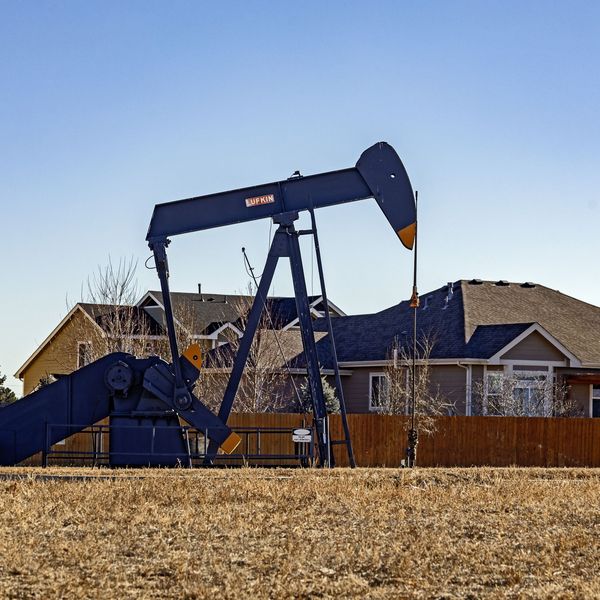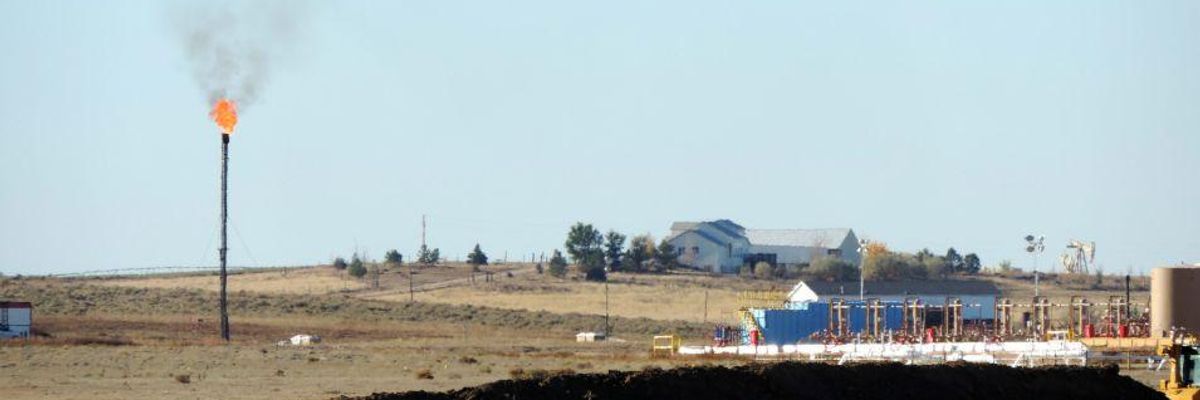Driven primarily by human activities including fossil fuel extraction, methane levels in the atmosphere had their fourth-largest annual increase in 2022, the National Oceanic and Atmospheric Administration reported Thursday.
Scientists detected 1,911.9 parts per billion (ppb) of methane in the atmosphere last year, indicating a rise of 14 ppb. The level rose by 17.75 ppb in 2021 and 15.20 ppb the previous year.
Benjamin Poulter, a scientist with the National Aeronautics and Space Administration (NASA), told the Associated Press that researchers are "confident that over half of the methane emissions are coming from human activities like oil and gas extraction, agriculture, waste management, and landfills."
Methane can trap about 87 times more heat than carbon dioxide in its first two decades in the atmosphere.
Responding to NOAA's report on atmospheric levels of carbon dioxide, methane, and nitrous oxide, Sierra Club campaigner Jens Wieting said that "allowing any new fossil fuel projects, more fracking, and [liquefied natural gas] is an unspeakable climate crime."
\u201cMethane levels in the atmosphere now more than 2.5x their pre-industrial level. The oil & gas sector is the largest industrial source of methane. Allowing any new fossil fuel projects, more #fracking & #LNG is an unspeakable #climatecrime #bcpoli #cdnpoli https://t.co/Wlbj3Gg6xw\u201d— Jens Wieting (@Jens Wieting) 1680805178
About 26% of the planetary heating that is attributed to human activity is caused by methane emissions from sources such as landfills, livestock, and oil and gas extraction, Duke University professor Drew Shindell told the AP Thursday.
\u201cThe story of methane's rise continues to focus on sources, but carbon monoxide from wildfires, leaking hydrogen, covid-19 emission reductions, changes in shipping fuels and loss of the forest sink are all contributing to existing methane persisting longer.\nhttps://t.co/8obq4yrFFv\u201d— Prof. Eliot Jacobson (@Prof. Eliot Jacobson) 1680823132
"If this rapid rise is wetlands and natural systems responding to climate change, then that's very frightening because we can't do much to stop it," Shindell told the AP. "If methane leaks from the fossil fuels sector, then we can make regulations. But we can't make regulations on what swamps do."
Policymakers must take action to cut the methane emissions that can be reduced, said NOAA.
"The time is now," said NOAA Administrator Rick Spinrad in a statement, "to address greenhouse gas pollution and to lower human-caused emissions as we continue to build toward a climate-ready nation."
An Urgent Message From Our Co-Founder
Dear Common Dreams reader, The U.S. is on a fast track to authoritarianism like nothing I've ever seen. Meanwhile, corporate news outlets are utterly capitulating to Trump, twisting their coverage to avoid drawing his ire while lining up to stuff cash in his pockets. That's why I believe that Common Dreams is doing the best and most consequential reporting that we've ever done. Our small but mighty team is a progressive reporting powerhouse, covering the news every day that the corporate media never will. Our mission has always been simple: To inform. To inspire. And to ignite change for the common good. Now here's the key piece that I want all our readers to understand: None of this would be possible without your financial support. That's not just some fundraising cliche. It's the absolute and literal truth. We don't accept corporate advertising and never will. We don't have a paywall because we don't think people should be blocked from critical news based on their ability to pay. Everything we do is funded by the donations of readers like you. Will you donate now to help power the nonprofit, independent reporting of Common Dreams? Thank you for being a vital member of our community. Together, we can keep independent journalism alive when it’s needed most. - Craig Brown, Co-founder |
Driven primarily by human activities including fossil fuel extraction, methane levels in the atmosphere had their fourth-largest annual increase in 2022, the National Oceanic and Atmospheric Administration reported Thursday.
Scientists detected 1,911.9 parts per billion (ppb) of methane in the atmosphere last year, indicating a rise of 14 ppb. The level rose by 17.75 ppb in 2021 and 15.20 ppb the previous year.
Benjamin Poulter, a scientist with the National Aeronautics and Space Administration (NASA), told the Associated Press that researchers are "confident that over half of the methane emissions are coming from human activities like oil and gas extraction, agriculture, waste management, and landfills."
Methane can trap about 87 times more heat than carbon dioxide in its first two decades in the atmosphere.
Responding to NOAA's report on atmospheric levels of carbon dioxide, methane, and nitrous oxide, Sierra Club campaigner Jens Wieting said that "allowing any new fossil fuel projects, more fracking, and [liquefied natural gas] is an unspeakable climate crime."
\u201cMethane levels in the atmosphere now more than 2.5x their pre-industrial level. The oil & gas sector is the largest industrial source of methane. Allowing any new fossil fuel projects, more #fracking & #LNG is an unspeakable #climatecrime #bcpoli #cdnpoli https://t.co/Wlbj3Gg6xw\u201d— Jens Wieting (@Jens Wieting) 1680805178
About 26% of the planetary heating that is attributed to human activity is caused by methane emissions from sources such as landfills, livestock, and oil and gas extraction, Duke University professor Drew Shindell told the AP Thursday.
\u201cThe story of methane's rise continues to focus on sources, but carbon monoxide from wildfires, leaking hydrogen, covid-19 emission reductions, changes in shipping fuels and loss of the forest sink are all contributing to existing methane persisting longer.\nhttps://t.co/8obq4yrFFv\u201d— Prof. Eliot Jacobson (@Prof. Eliot Jacobson) 1680823132
"If this rapid rise is wetlands and natural systems responding to climate change, then that's very frightening because we can't do much to stop it," Shindell told the AP. "If methane leaks from the fossil fuels sector, then we can make regulations. But we can't make regulations on what swamps do."
Policymakers must take action to cut the methane emissions that can be reduced, said NOAA.
"The time is now," said NOAA Administrator Rick Spinrad in a statement, "to address greenhouse gas pollution and to lower human-caused emissions as we continue to build toward a climate-ready nation."
- 'Worst Possible News': Scientists Urge Immediate Action as Greenhouse Gas Levels Hit All-Time High ›
- Drilling Operations, Wildfires Emitting Far More Methane Than Previously Known: Studies ›
- 'Trashing the Climate': EPA Failing to Address Massive Methane Emissions From Landfills ›
- Petition Demands EPA Take Action on 'Under-the-Radar' Methane Emissions From Landfills ›
- Study Shows Methane Leaks Put Climate Risk From Gas 'On Par With Coal' ›
Driven primarily by human activities including fossil fuel extraction, methane levels in the atmosphere had their fourth-largest annual increase in 2022, the National Oceanic and Atmospheric Administration reported Thursday.
Scientists detected 1,911.9 parts per billion (ppb) of methane in the atmosphere last year, indicating a rise of 14 ppb. The level rose by 17.75 ppb in 2021 and 15.20 ppb the previous year.
Benjamin Poulter, a scientist with the National Aeronautics and Space Administration (NASA), told the Associated Press that researchers are "confident that over half of the methane emissions are coming from human activities like oil and gas extraction, agriculture, waste management, and landfills."
Methane can trap about 87 times more heat than carbon dioxide in its first two decades in the atmosphere.
Responding to NOAA's report on atmospheric levels of carbon dioxide, methane, and nitrous oxide, Sierra Club campaigner Jens Wieting said that "allowing any new fossil fuel projects, more fracking, and [liquefied natural gas] is an unspeakable climate crime."
\u201cMethane levels in the atmosphere now more than 2.5x their pre-industrial level. The oil & gas sector is the largest industrial source of methane. Allowing any new fossil fuel projects, more #fracking & #LNG is an unspeakable #climatecrime #bcpoli #cdnpoli https://t.co/Wlbj3Gg6xw\u201d— Jens Wieting (@Jens Wieting) 1680805178
About 26% of the planetary heating that is attributed to human activity is caused by methane emissions from sources such as landfills, livestock, and oil and gas extraction, Duke University professor Drew Shindell told the AP Thursday.
\u201cThe story of methane's rise continues to focus on sources, but carbon monoxide from wildfires, leaking hydrogen, covid-19 emission reductions, changes in shipping fuels and loss of the forest sink are all contributing to existing methane persisting longer.\nhttps://t.co/8obq4yrFFv\u201d— Prof. Eliot Jacobson (@Prof. Eliot Jacobson) 1680823132
"If this rapid rise is wetlands and natural systems responding to climate change, then that's very frightening because we can't do much to stop it," Shindell told the AP. "If methane leaks from the fossil fuels sector, then we can make regulations. But we can't make regulations on what swamps do."
Policymakers must take action to cut the methane emissions that can be reduced, said NOAA.
"The time is now," said NOAA Administrator Rick Spinrad in a statement, "to address greenhouse gas pollution and to lower human-caused emissions as we continue to build toward a climate-ready nation."
- 'Worst Possible News': Scientists Urge Immediate Action as Greenhouse Gas Levels Hit All-Time High ›
- Drilling Operations, Wildfires Emitting Far More Methane Than Previously Known: Studies ›
- 'Trashing the Climate': EPA Failing to Address Massive Methane Emissions From Landfills ›
- Petition Demands EPA Take Action on 'Under-the-Radar' Methane Emissions From Landfills ›
- Study Shows Methane Leaks Put Climate Risk From Gas 'On Par With Coal' ›


